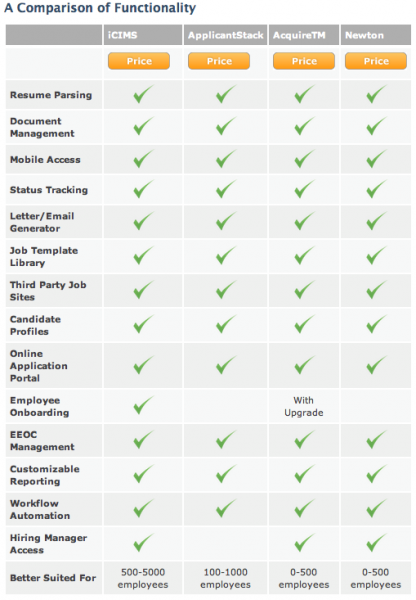A Beginner’s Guide for Applicant Tracking Systems
Are you a hiring professional working in a small or mid-sized business? When your organization announces, “We’re hiring again,” are your paralyzed with the fear of being buried under stacks of resumes? The process of reviewing resumes, interviewing candidates, and hiring/on-boarding is time-consuming. When searching for the proverbial needle in a haystack, keeping organized should should be easier. Thankfully, there’s a light at the end of the tunnel. Due largely in part to the emergence of web-based Software as a Service (SaaS), organizations of any size and budget can tap into feature-rich web-based applicant tracking software (ATS ) and streamline their hiring process.
As an alternative to traditional on-premise systems are still popular, web-based software as a service (Saas) put big-time functionality at hiring professionals’ disposal without the upfront expense of on-premise implementations. In fact, according to a report published by Advanced Market Research, SaaS users are part of the fastest growing market of consumers in HR software – contributing more than one-third of revenue for software companies.
So, if you think you may be ready to get rid of your Rolodex and clear that stack of resumes off of your desk, here’s what you should know…
A Closer Look at Web-based Applicant Tracking Software:
ATS automates the hiring process from end to end in the – from how candidates view openings and complete online applications to scheduling interviews and securely storing resumes. And central to the process is ensuring that this workflow is easily accessible to everyone from the HR specialist to the CEO.

Most applicant tracking systems include a portal where candidates can complete customizable online applications. Resumes are parsed at the click of a button and document templates (i.e. offer letters) are quickly generated as well. Multiple schedules can also easily be coordinated so you can focus on interviewing. The ultimate focus of applicant tracking systems is the successful management of candidates’ lifecycles in the hiring process.
There are many applicant tracking solutions, as there are various needs across the industries (i.e. high volume of applicants, various positions to be filled, etc). As such, we’ve put together this comparison of some of our favorite systems:
How to Know When You Need Recruitment Software
Many small and mid-sized businesses have a clear-cut need for ATS, but they often don’t know if now is the right time to invest. Here are a few indications you might be ready to take the plunge and invest in applicant tracking or recruiting software:
? Your business is growing. Adding positions in every department except HR? You’ve got your work cut out for you. Applicant tracking software often opens the lines of communication and enables interdepartmental communication, bringing the decision-makers together and fostering much needed collaboration in the hiring process.
? You’re wearing too many hats.In this economy, a single job posting can see your inbox flooded with resumes. And for a small business that’s already overloaded, and it can be a struggle to find the time needed to hire the right people – and tend to your daily responsibilities. Reducing the amount of paperwork to streamline the interview and hiring process can go a long way in lightening your workload. Applicant tracking and recruiting software can also help ensure the best candidates don’t get lost in the shuffle.
? Your business has high turnover. If you work in an industry where turnover unfortunately is a common trend (retail, food service, hospitality, etc), hiring can be a never-ending process. With resumes constantly streaming in, it’s difficult to keep. The sheer volume of background checks, interviews, and onboarding can overwhelm anyone – not to mention filing these candidates’ applications for compliance. Automating your hiring keeps you organized so you can manage this process efficiently and easily.
? You need help tracking and reporting EEOC compliance. Claiming “I didn’t know,” probably isn’t the best defense in a court of law, and non-compliance can result in serious cash for litigation, settlement and fines. Many applicant tracking systems have EEOC compliance best practices built into their workflow. So you can easily monitor compliance in real time, and reports can produced in an instant. If the thought of an audit keeps you up at night, knowing you have the right measures in place can help you focus on the other things that matter to growing your bottom line.
How to Choose the Right Software for Your Organization
According to HR technology blogger Steve Boese, “There is almost no reason why even the smallest, least technically capable organizations and HR departments can’t take advantage of at least some level of automation to better manage the recruiting process.” Software developers understand that the hiring process varies from organization to organization, and there are more than 200 applicant tracking systems for you to choose from.
If you’re a small business owner, the first step in choosing the right applicant tracking software is identifying your needs and budget. If you’re new to applicant tracking, you’ll want to start with the basics in terms of functionality: online applications, interview status tracking, and document management. Or, if you’re ready for a complete package to deliver for years to come, go for the gold and invest in a top-of-the-line best of breed solution.
The next step is to know what the market has to offer. With the right due diligence, you’ll be able to make the best decision for your specific needs to ensure you can attract and hire the very best applicants to help take your small business to the next level.

